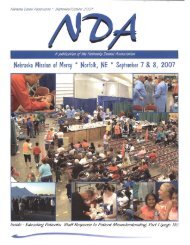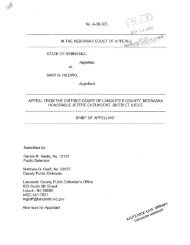Financial Articulation of a Fiduciary Duty to Bondholders with ...
Financial Articulation of a Fiduciary Duty to Bondholders with ...
Financial Articulation of a Fiduciary Duty to Bondholders with ...
Create successful ePaper yourself
Turn your PDF publications into a flip-book with our unique Google optimized e-Paper software.
1986] FIDUCIARY DUTY TO BONDHOLDERS<br />
A risk-averse s<strong>to</strong>ckholder equitable owner <strong>of</strong> such corporate assets<br />
would not seek unanticipated increases in their instantaneous variance<br />
because increased variance equally increases the chances for<br />
decreased values along <strong>with</strong> increased values. 66 However, a riskaverse<br />
s<strong>to</strong>ckholder equitable owner <strong>of</strong> a call option on such assets<br />
would seek, ceteris paribus, 67 unanticipated increases in their instantaneous<br />
variance when the call option's exercise price is (1) greater<br />
than the expected value <strong>of</strong> such assets, because increased variance increases<br />
the chances for exercising the call option, 68 and (2) less than<br />
the expected value <strong>of</strong> such assets while the corporation's asset instantaneous<br />
covariance risk and capital-structure-unaffected market<br />
value 69 are constant, 70 because increased variance decreases the instantaneous<br />
covariance risk <strong>of</strong> the corporation's s<strong>to</strong>cks and increases<br />
their market value. 71 Situation (1) admits <strong>of</strong> unanticipated wealth<br />
expropriations from bondholders through waste <strong>of</strong> corporate assets<br />
because there is a significant chance <strong>of</strong> corporate bankruptcy when<br />
the call option's exercise price is greater than the expected value <strong>of</strong><br />
the corporation's assets. 72 Situation (2) admits <strong>of</strong> unanticipated<br />
wealth expropriations from bondholders through: (a) wealth redistributions<br />
because an increase in the s<strong>to</strong>cks' market value correspondingly<br />
decreases the bonds' market value, 73 and (b) inefficient use <strong>of</strong><br />
corporate assets because <strong>of</strong> the chance "that a more pr<strong>of</strong>itable<br />
66. A risk-averse (decreasing positive marginal utility <strong>of</strong> wealth <strong>with</strong> increasing<br />
wealth) individual would not desire <strong>to</strong> participate in an investment having an equal<br />
chance <strong>of</strong> equal gain or loss because the increase in utility from such gain is less than<br />
the decrease in utility from such loss: the net utility from such chances is less than the<br />
utility <strong>of</strong> not taking such chances. See supra note 53.<br />
67. "Ceteris paribus" means "if all other relevant things (as fac<strong>to</strong>rs or elements)<br />
correspond or remain unaltered." WEBSTER'S THIRD NEW INTERNATIONAL DICTIONARY<br />
368 (1976).<br />
68. Increased variance (dispersion) increases the portion (tail) <strong>of</strong> the pr<strong>of</strong>ile (distribution)<br />
<strong>of</strong> chances <strong>of</strong> asset values above the call option's exercise price.<br />
69. "Capital-structure-unaffected market value" means that the corporation's<br />
market value is the sum <strong>of</strong> the market values <strong>of</strong> its bonds and s<strong>to</strong>cks unaffected by the<br />
market value ratio <strong>of</strong> its bonds <strong>to</strong> s<strong>to</strong>cks. See Smith, Jr., supra note 31, at 45. See generally<br />
Modigliani & Miller, The Cost <strong>of</strong> Capital, Corporation Finance and the Theory <strong>of</strong><br />
Investment, 48 AM. ECON. REV. 261, 268 (1958) (stating that "the market value <strong>of</strong> any<br />
firm is independent <strong>of</strong> its capital structure"); Stiglitz, A Re-Examination <strong>of</strong> the Modigliani-Mioller<br />
Theorem, 59 AM. ECON. REV. 784, 788-89 (1969).<br />
70. Galai & Masulis, supra note 27, at 56 & n.10, 58-60, 62-64, 71 & n.52 (discussing<br />
the conjoint use <strong>of</strong> the Black-Scholes option-pricing model and the intertemporal capital-asset-pricing<br />
model).<br />
71. Id. at 59-60, 63-64, 71 & n.53. For examples that the concept <strong>of</strong> decreasing<br />
s<strong>to</strong>ckholders' covariance risk by increasing the risk <strong>of</strong> corporate bankruptcy is apparently<br />
foreign <strong>to</strong> our commenta<strong>to</strong>rs, see Easterbrook & Fischel, supra note 5, at 1442;<br />
McDaniel, <strong>Bondholders</strong> and Corporate Governance, 41 Bus. LAW. 413, 433-34 (1986).<br />
Diversifiable risk becomes economically irrelevant <strong>to</strong> risk-averse s<strong>to</strong>ckholders through<br />
their investment diversification in the efficient capital market.<br />
72. See supra notes 10, 23 and accompanying text.<br />
73. Galai & Masulis, supra note 27, at 58-60, 63-64, 71 & n.53.








